6.11: Human Tissues
- Page ID
- 92647
\( \newcommand{\vecs}[1]{\overset { \scriptstyle \rightharpoonup} {\mathbf{#1}} } \)
\( \newcommand{\vecd}[1]{\overset{-\!-\!\rightharpoonup}{\vphantom{a}\smash {#1}}} \)
\( \newcommand{\dsum}{\displaystyle\sum\limits} \)
\( \newcommand{\dint}{\displaystyle\int\limits} \)
\( \newcommand{\dlim}{\displaystyle\lim\limits} \)
\( \newcommand{\id}{\mathrm{id}}\) \( \newcommand{\Span}{\mathrm{span}}\)
( \newcommand{\kernel}{\mathrm{null}\,}\) \( \newcommand{\range}{\mathrm{range}\,}\)
\( \newcommand{\RealPart}{\mathrm{Re}}\) \( \newcommand{\ImaginaryPart}{\mathrm{Im}}\)
\( \newcommand{\Argument}{\mathrm{Arg}}\) \( \newcommand{\norm}[1]{\| #1 \|}\)
\( \newcommand{\inner}[2]{\langle #1, #2 \rangle}\)
\( \newcommand{\Span}{\mathrm{span}}\)
\( \newcommand{\id}{\mathrm{id}}\)
\( \newcommand{\Span}{\mathrm{span}}\)
\( \newcommand{\kernel}{\mathrm{null}\,}\)
\( \newcommand{\range}{\mathrm{range}\,}\)
\( \newcommand{\RealPart}{\mathrm{Re}}\)
\( \newcommand{\ImaginaryPart}{\mathrm{Im}}\)
\( \newcommand{\Argument}{\mathrm{Arg}}\)
\( \newcommand{\norm}[1]{\| #1 \|}\)
\( \newcommand{\inner}[2]{\langle #1, #2 \rangle}\)
\( \newcommand{\Span}{\mathrm{span}}\) \( \newcommand{\AA}{\unicode[.8,0]{x212B}}\)
\( \newcommand{\vectorA}[1]{\vec{#1}} % arrow\)
\( \newcommand{\vectorAt}[1]{\vec{\text{#1}}} % arrow\)
\( \newcommand{\vectorB}[1]{\overset { \scriptstyle \rightharpoonup} {\mathbf{#1}} } \)
\( \newcommand{\vectorC}[1]{\textbf{#1}} \)
\( \newcommand{\vectorD}[1]{\overrightarrow{#1}} \)
\( \newcommand{\vectorDt}[1]{\overrightarrow{\text{#1}}} \)
\( \newcommand{\vectE}[1]{\overset{-\!-\!\rightharpoonup}{\vphantom{a}\smash{\mathbf {#1}}}} \)
\( \newcommand{\vecs}[1]{\overset { \scriptstyle \rightharpoonup} {\mathbf{#1}} } \)
\( \newcommand{\vecd}[1]{\overset{-\!-\!\rightharpoonup}{\vphantom{a}\smash {#1}}} \)
\(\newcommand{\avec}{\mathbf a}\) \(\newcommand{\bvec}{\mathbf b}\) \(\newcommand{\cvec}{\mathbf c}\) \(\newcommand{\dvec}{\mathbf d}\) \(\newcommand{\dtil}{\widetilde{\mathbf d}}\) \(\newcommand{\evec}{\mathbf e}\) \(\newcommand{\fvec}{\mathbf f}\) \(\newcommand{\nvec}{\mathbf n}\) \(\newcommand{\pvec}{\mathbf p}\) \(\newcommand{\qvec}{\mathbf q}\) \(\newcommand{\svec}{\mathbf s}\) \(\newcommand{\tvec}{\mathbf t}\) \(\newcommand{\uvec}{\mathbf u}\) \(\newcommand{\vvec}{\mathbf v}\) \(\newcommand{\wvec}{\mathbf w}\) \(\newcommand{\xvec}{\mathbf x}\) \(\newcommand{\yvec}{\mathbf y}\) \(\newcommand{\zvec}{\mathbf z}\) \(\newcommand{\rvec}{\mathbf r}\) \(\newcommand{\mvec}{\mathbf m}\) \(\newcommand{\zerovec}{\mathbf 0}\) \(\newcommand{\onevec}{\mathbf 1}\) \(\newcommand{\real}{\mathbb R}\) \(\newcommand{\twovec}[2]{\left[\begin{array}{r}#1 \\ #2 \end{array}\right]}\) \(\newcommand{\ctwovec}[2]{\left[\begin{array}{c}#1 \\ #2 \end{array}\right]}\) \(\newcommand{\threevec}[3]{\left[\begin{array}{r}#1 \\ #2 \\ #3 \end{array}\right]}\) \(\newcommand{\cthreevec}[3]{\left[\begin{array}{c}#1 \\ #2 \\ #3 \end{array}\right]}\) \(\newcommand{\fourvec}[4]{\left[\begin{array}{r}#1 \\ #2 \\ #3 \\ #4 \end{array}\right]}\) \(\newcommand{\cfourvec}[4]{\left[\begin{array}{c}#1 \\ #2 \\ #3 \\ #4 \end{array}\right]}\) \(\newcommand{\fivevec}[5]{\left[\begin{array}{r}#1 \\ #2 \\ #3 \\ #4 \\ #5 \\ \end{array}\right]}\) \(\newcommand{\cfivevec}[5]{\left[\begin{array}{c}#1 \\ #2 \\ #3 \\ #4 \\ #5 \\ \end{array}\right]}\) \(\newcommand{\mattwo}[4]{\left[\begin{array}{rr}#1 \amp #2 \\ #3 \amp #4 \\ \end{array}\right]}\) \(\newcommand{\laspan}[1]{\text{Span}\{#1\}}\) \(\newcommand{\bcal}{\cal B}\) \(\newcommand{\ccal}{\cal C}\) \(\newcommand{\scal}{\cal S}\) \(\newcommand{\wcal}{\cal W}\) \(\newcommand{\ecal}{\cal E}\) \(\newcommand{\coords}[2]{\left\{#1\right\}_{#2}}\) \(\newcommand{\gray}[1]{\color{gray}{#1}}\) \(\newcommand{\lgray}[1]{\color{lightgray}{#1}}\) \(\newcommand{\rank}{\operatorname{rank}}\) \(\newcommand{\row}{\text{Row}}\) \(\newcommand{\col}{\text{Col}}\) \(\renewcommand{\row}{\text{Row}}\) \(\newcommand{\nul}{\text{Nul}}\) \(\newcommand{\var}{\text{Var}}\) \(\newcommand{\corr}{\text{corr}}\) \(\newcommand{\len}[1]{\left|#1\right|}\) \(\newcommand{\bbar}{\overline{\bvec}}\) \(\newcommand{\bhat}{\widehat{\bvec}}\) \(\newcommand{\bperp}{\bvec^\perp}\) \(\newcommand{\xhat}{\widehat{\xvec}}\) \(\newcommand{\vhat}{\widehat{\vvec}}\) \(\newcommand{\uhat}{\widehat{\uvec}}\) \(\newcommand{\what}{\widehat{\wvec}}\) \(\newcommand{\Sighat}{\widehat{\Sigma}}\) \(\newcommand{\lt}{<}\) \(\newcommand{\gt}{>}\) \(\newcommand{\amp}{&}\) \(\definecolor{fillinmathshade}{gray}{0.9}\)This photo in Figure \(\PageIndex{1}\) looks like a close-up of an old-fashioned dust mop, and the object it shows has a somewhat similar function. However, the object is greatly enlarged in the photo. Can you guess what it is? The answer may surprise you. It is a scanning electron micrograph of human epithelial cells that line the bronchial passages. The floppy, dust-mop-like extensions are actually microscopic structures called cilia projecting from the outer surface of the epithelial cells. The function of the cilia is to trap dust, pathogens, and other particles in the air before it enters the lungs. The cilia also sway back and forth to sweep the trapped particles upward toward the throat, from which they can be expelled from the body.
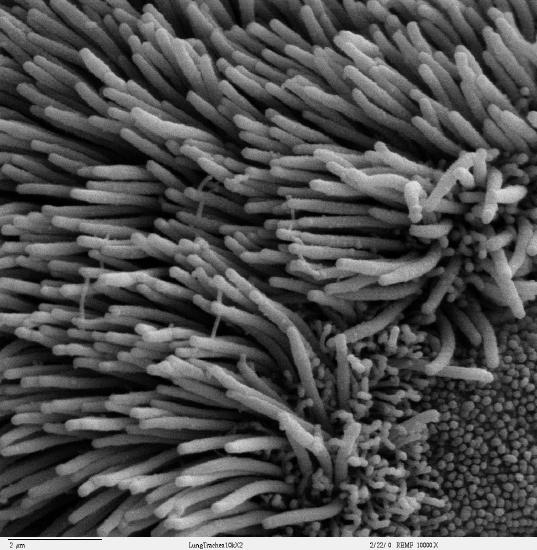
Human Cells
Like the ciliated bronchial cells in the micrograph above, many other cells in the human body are very distinctive and well suited for special functions. To perform their special functions, cells may vary in a number of ways.
Variation in Human Cells
Some cells act as individual cells and are not attached to one another. Red blood cells are a good example. Their main function is to transport oxygen to other cells throughout the body, so they must be able to move freely through the circulatory system. Many other cells, in contrast, act together with other similar cells as part of the same tissue, so they are attached to one another and cannot move freely. For example, epithelial cells lining the respiratory tract are attached to each other to form a continuous surface that protects the respiratory system from particles and other hazards in the air.
Many cells can divide readily and form new cells. Skin cells are constantly dying and being shed from the body and replaced by new skin cells, and bone cells can divide to form new bone for growth or repair. Some other cells, in contrast, such as certain nerve cells, can divide and form new cells only under exceptional circumstances. That’s why nervous system injuries such as a severed spinal cord generally cannot heal by the production of new cells, resulting in a permanent loss of function.
Many human cells have the primary job of producing and secreting a particular substance, such as a hormone or an enzyme. For example, special cells in the pancreas produce and secrete the hormone insulin, which regulates the level of glucose in the blood. Some of the epithelial cells that line the bronchial passages produce mucus, a sticky substance that helps trap particles in the air before it passes into the lungs.
Different but Identical
All the different cell types within an individual human organism are genetically identical, so no matter how different the cells are, they all have the same genes. How can such different types of cells arise? The answer is the differential regulation of genes. Cells with the same genes can be very different because different genes are expressed depending on the cell type.
Examples of Human Cell Types
Many common types of human cells — such as bone cells and white blood cells — actually consist of several subtypes of cells. Each subtype, in turn, has a special structure and function. A closer look at these cell types will give you a better appreciation for the diversity of structures and functions of human cells.
Bone Cells
There are four main subtypes of bone cells, as shown in Figure \(\PageIndex{2}\). Each type has a different form and function:
- Osteocytes are star-shaped bone cells that make up the majority of bone tissue. They are the most common cells in mature bone and can live as long as the organism itself. They also control the function of bone cells called osteoblasts and osteoclasts.
- Osteoblasts are cells with single nuclei that synthesize new bone. They function in organized groups of connected cells called osteons to form the organic and mineral matrix of bone.
- Osteogenic cells are undifferentiated stem cells that differentiate to form osteoblasts in the tissue that covers the outside of the bone.
- Osteoclasts are very large, multinucleated cells that are responsible for the breakdown of bones through resorption. The breakdown of bone is very important in bone health because it allows for bone remodeling.
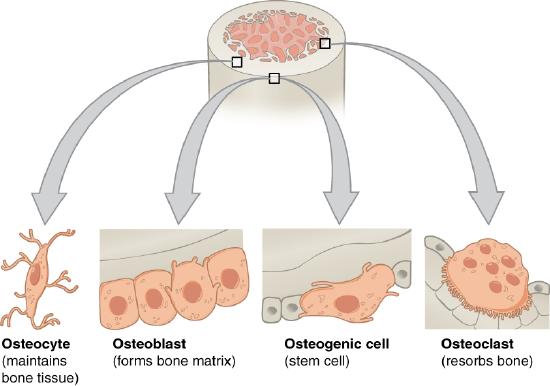
White Blood Cells
White blood cells (also called leukocytes) are even more variable than bone cells. Five subtypes of white blood cells are shown in Figure \(\PageIndex{3}\). All of them are immune system cells involved in defending the body, but each subtype has a different function. They also differ in the normal proportion of all leukocytes they make up.
- Monocytes make up about 5 percent of leukocytes. They are the biggest cells with extensions and a kidney-shaped nucleus. They engulf and destroy (phagocytize) pathogens in tissues.
- Eosinophils make up about 2 percent of leukocytes. They have and a bilobed nucleus. They attack larger parasites and set off allergic responses.
- Basophils make up less than 1 percent of leukocytes. Like eosinophils, these cells also have granules and a bilobed nucleus. They release proteins called histamines that are involved in inflammation.
- Lymphocytes make up about 30 percent of leukocytes. These are small cells with a large circular nucleus. They include B cells and T cells. B cells produce antibodies against non-self antigens, and T cells destroy virus-infected cells and cancer cells.
- Neutrophils are the most numerous white blood cells, making up about 62 percent of leukocytes. They have granules and a multilobed nucleus. They phagocytize single-celled bacteria and fungi in the blood.
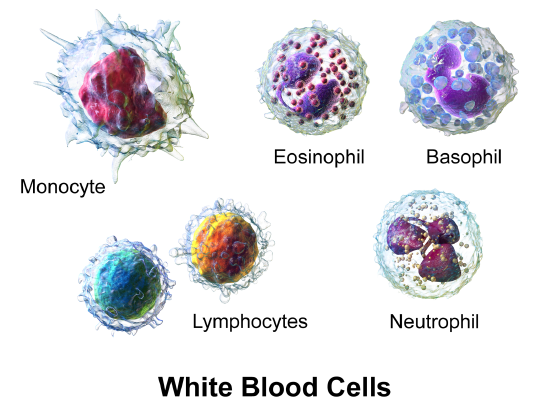
Tissues
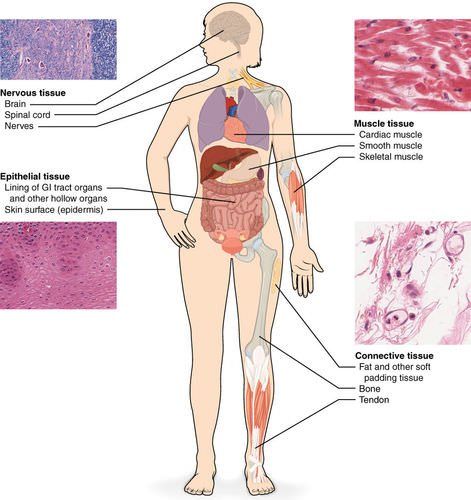
Groups of connected cells form tissues. The cells in a tissue may all be the same type or they may be of multiple types. In either case, the cells in the tissue work together to carry out a specific function. There are four main types of human tissues: connective, epithelial, muscle, and nervous tissues.
Connective Tissue
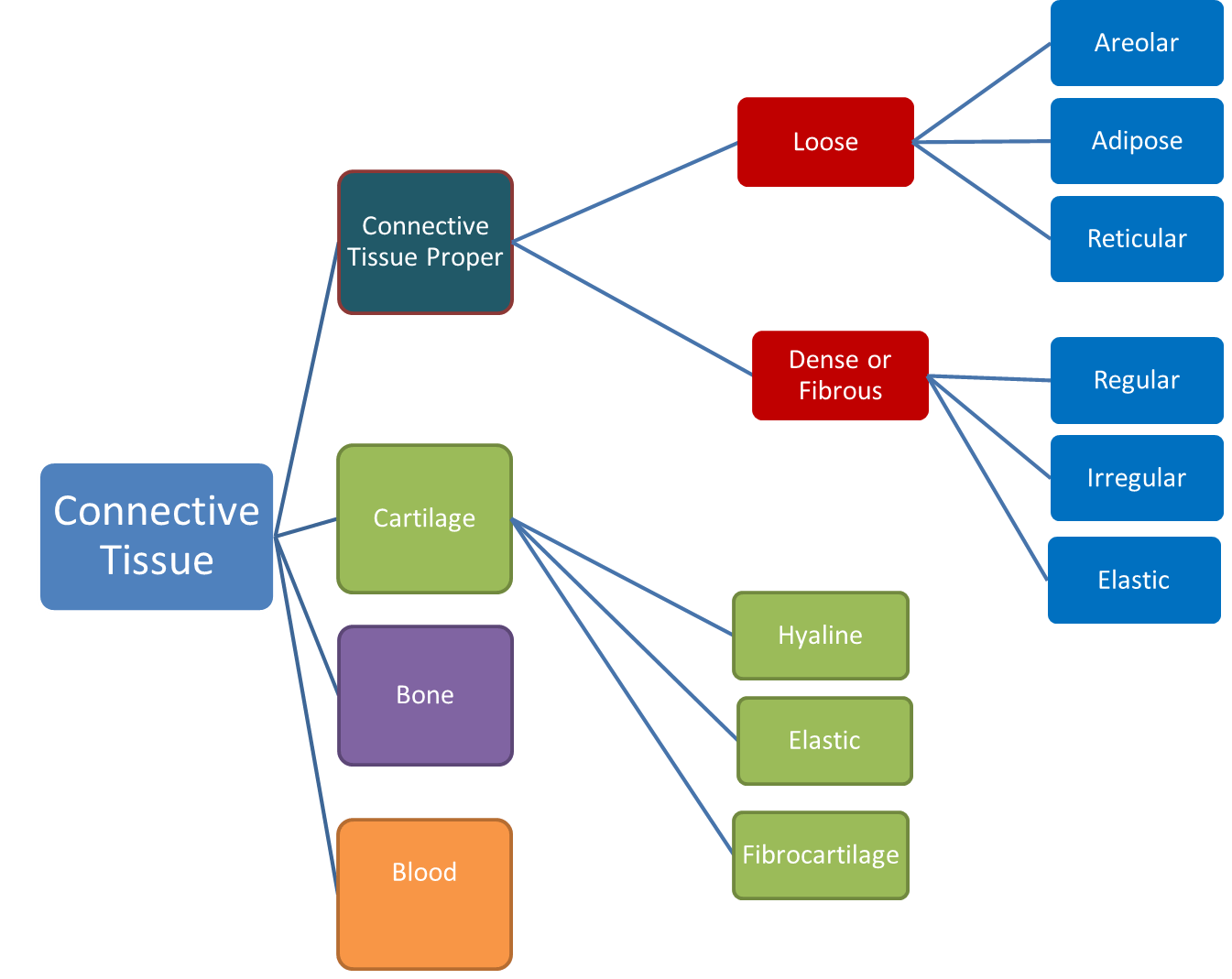
The most diverse and abundant of all tissues, connective tissue holds cells together and supports the body. Connective tissue is made up of cells suspended in a non-cellular matrix. The matrix (also known as ground substance) is secreted by the connective tissue cells and determines the characteristics of the connective tissue. It is the consistency of the matrix that determines the function of the connective tissue. The matrix can be liquid, gel-like or solid, all depending on the type of connective tissue. For example, the extracellular matrix of bone is a rigid mineral framework. The extracellular matrix of blood is liquid plasma. Connective tissues such as bone and cartilage generally form the body's structure. There are many sub-types of the four major types of tissues in a human body, see the flow chart in Figure \(\PageIndex{5}\).
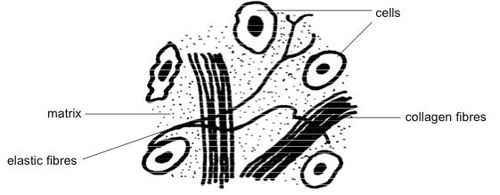
Connective Tissue Proper
Fibroblast cells are responsible for synthesizing protein fibers for the matrix. Collagen fibers are strong, elastic fibers are flexible and reticular fibers form a supportive framework for organs and basement membranes. There are two subcategories of connective tissue proper.
Loose connective tissue
Thin and soft, this tissue contains many collagen and elastic fibers in a jell-like matrix. The cells in loose connective tissue are not close together. This tissue functions in binding the skin to underlying structures. There are three types of loose connective tissue.
- Areolar connective tissue is a common form of loose connective tissue. It is found in the skin and mucous membranes, where it binds the skin or membrane to underlying tissues such as muscles. It is also found around blood vessels and internal organs where it links and supports them.
- Adipose connective tissue is commonly known as fat. This tissue contains fat cells that are specialized for lipid storage. In addition to storing energy, this tissue also cushions and protects the organs.
- Reticular connective tissue is mostly composed of reticular protein fibers which make a skeleton, known as stroma, for the lymphatic and white blood cells. This type of tissue is found in the spleen and other lymphatic system structures.
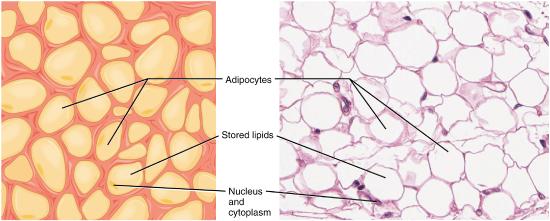

Dense connective tissue proper
This tissue consists of three categories, dense regular connective tissue, dense irregular connective tissue, and elastic connective tissue. These tissues differ on the arrangement and composition of the fibrous elements of the extracellular matrix.
- Dense regular connective tissue has extracellular fibers that all run in the same direction and plane. Muscle tendons are a type of dense regular connective tissue.
- Dense irregular connective tissue contains collagen and elastic fibers which are found running in all different directions and planes. The dermis of the skin is composed of dense irregular connective tissue.
- Elastic connective tissue: Made up of freely branching elastic fibers with fibroblasts in the spaces between the fibers, this tissue allows the kind of stretch that is found in the walls of arteries.
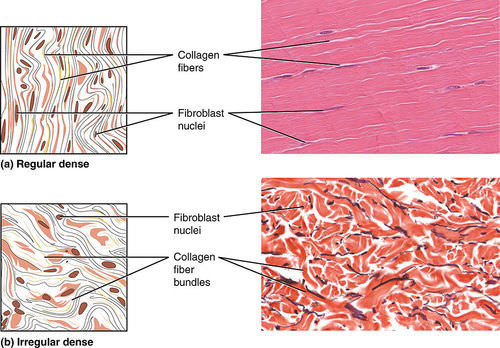
Figure \(\PageIndex{9}\): (a) Dense regular connective tissue consists of collagen fibers packed into parallel bundles. (b) Dense irregular connective tissue consists of collagen fibers interwoven into a mesh-like network..
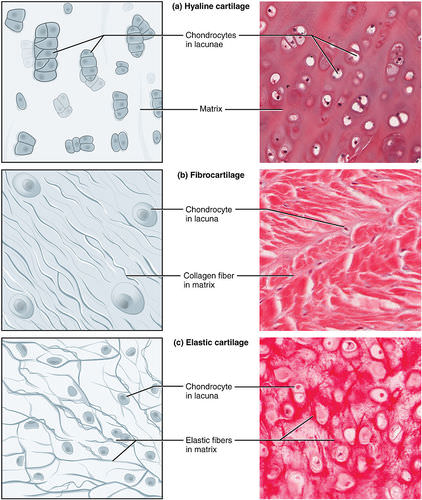
Figure \(\PageIndex{10}\): Cartilage is a connective tissue consisting of collagenous fibers embedded in a firm matrix of chondroitin sulfates. (a) Hyaline cartilage has chondrocytes in lacunae within a matrix. (b) Fibrocartilage has chondrocytes in lacunae within collage fibers in a matrix. (c) Elastic cartilage has chondrocytes in lacunae within elastic fibers in a matrix.
Cartilage
This connective tissue is relatively solid and is a non-vascularized tissue (does not have a blood supply). The matrix is produced by cells called chondroblasts. When these cells slow down, they reside is small spaces called lacunae. These mature cells in the lacunae are called chondrocytes. There are three types of cartilage: hyaline cartilage, elastic cartilage, and fibrocartilage.
- Hyaline cartilage is the most common type of cartilage, contains many collagen fibers and is found in many places including the nose, between the ribs and the sternum and in the rings of the trachea.
- Elastic cartilage has many elastic fibers in the matrix and supports the shape of the ears and forms part of the larynx.
- Fibrocartilage is tough and contains many collagen fibers and is responsible for cushioning the knee joint and for forming the disks between the vertebrae.
Bone
Bone is a hard, mineralized tissue found in the skeleton. The bone matrix contains many collagen fibers as well as inorganic mineral salts, calcium carbonate, and calcium phosphate, all features that make it a very rigid structure. Bone cells, called osteoblasts, secrete the osteoid substance that eventually hardens around the cells to form an ossified matrix. The osteon forms the basic unit of compact bone. Within the osteon, the osteocytes (mature bone cells) are located in lacunae. Because the bone matrix is very dense, the osteocytes get their nutrition from the central canal via tiny canals called canaliculi.
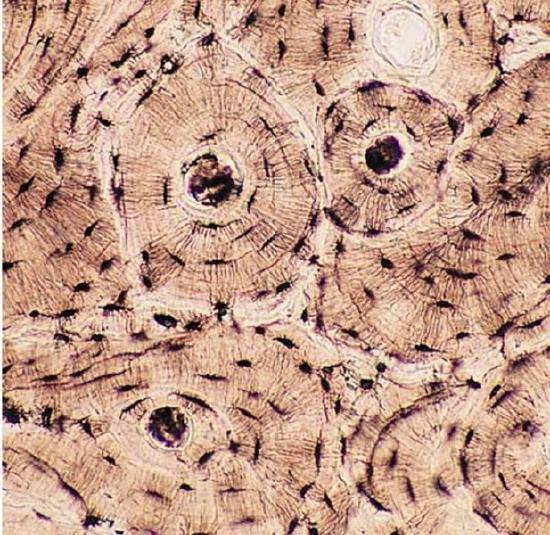
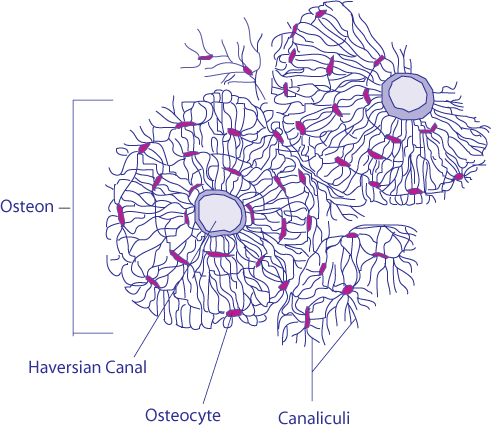
Blood
Blood is considered a type of fluid connective tissue because the matrix of blood is not solid. The fluid matrix is called plasma, and formed elements of this tissue include white blood cells, red blood cells, and platelets. Read more about the composition and function of blood in the cardiovascular system chapter.
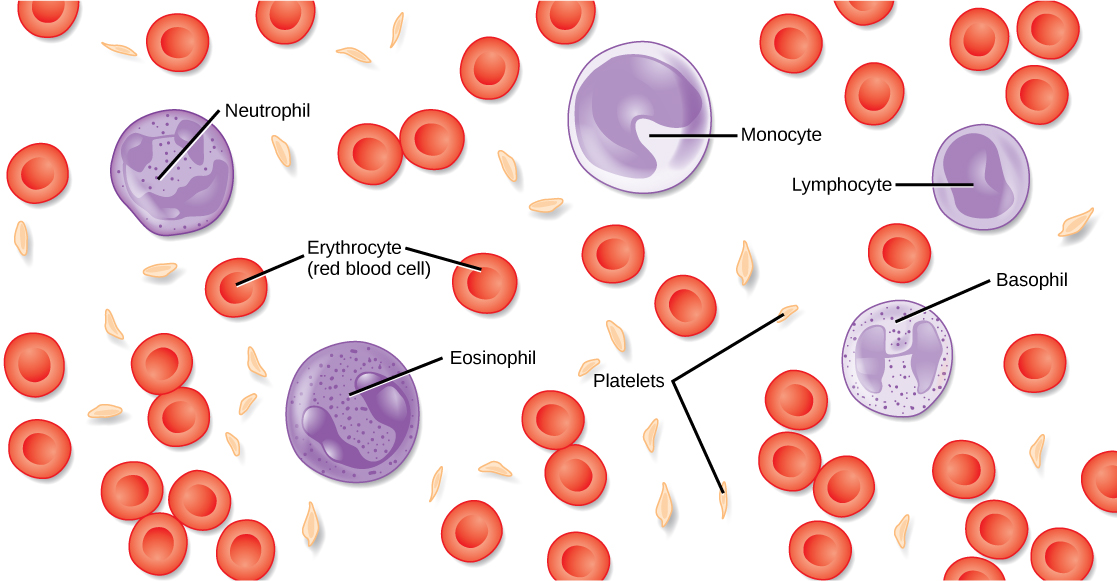
Epithelial Tissue
Epithelial tissue is made up of cells that line inner and outer body surfaces, such as the skin and the inner surface of the digestive tract. Epithelial tissue that lines inner body surfaces and body openings is called mucous membrane. This type of epithelial tissue produces mucus, a slimy substance that coats mucous membranes and traps pathogens, particles, and debris. Epithelial tissue protects the body and its internal organs, secretes substances such as hormones in addition to mucus, and absorbs substances such as nutrients.
Epithelial Cell Classification
Most epithelial tissue is described with two names. The first name describes the number of cell layers present and the second describes the shape of the cells. One layer of epithelial cells is called simple and more than one layer of epithelial cells is called stratified. There are three basic shapes of epithelial cells, squamous, cuboidal, and columnar. Squamous cells are thin and flat; cuboidal cells have a shape of a cube; columnar cells have a shape of a pillar. For example, simple squamous epithelial tissue describes a single layer of cells that are flat and scale-like in shape.
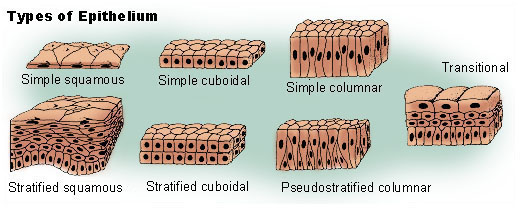
Locations and Functions of Epithelial Tissues
These tissues are found at various locations in our body and they have many functions. Some locations and functions are listed below:
- Simple squamous epithelium: This tissue is located in the sacs of the lungs and kidney where the exchange of nutrients and gas is essential.
- Simple cuboidal epithelium: This tissue is located in the glands and their ducts and kidneys. The main function of this tissue is secretion.
- Simple Columnar epithelium: This tissue lines the Gastrointestinal tract. The main function of this tissue is absorption and secretion.
- Pseudostratified epithelium: This is a simple tissue with the appearance of stratification. This tissue is located in the respiratory tract. This tissue may contain cilia to move mucus.
- Stratified squamous epithelium: This tissue is located where protection is needed such as skin.
- Stratified cuboidal epithelium: This tissue is located in the sweat glands for protection.
- Stratified columnar epithelium: This tissue is located in some sweat glands. The main function is to protect and secrete sweat components.
- Transitional epithelium: This tissue lines bladder, urethra, and ureters. The tissue allows the urinary organs to expand and stretch.
Muscle Tissue
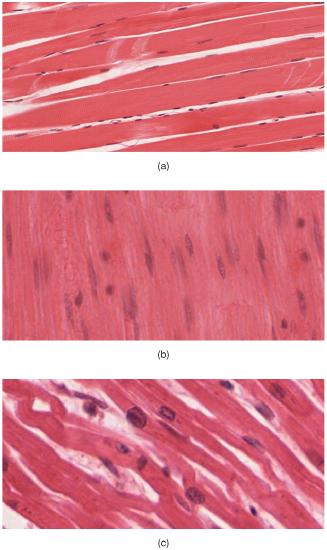
Muscle tissue is made up of cells that have the unique ability to contract or become shorter. There are three major types of muscle tissue, as pictured in Figure \(\PageIndex{14}\): skeletal, smooth, and cardiac muscle tissues.
- Skeletal muscles are striated, or striped in appearance, because of their internal structure. Skeletal muscles are attached to bones, and when they pull on the bones, they enable the body to move. Skeletal muscles are under voluntary control.
- Smooth muscles are nonstriated muscles. They are found in the walls of blood vessels and in the reproductive, gastrointestinal, and respiratory tracts. Smooth muscles are not under voluntary control.
- Cardiac muscles are striated and found only in the heart. Their contractions cause the heart to beat. Cardiac muscles are not under voluntary control.
Nervous Tissue
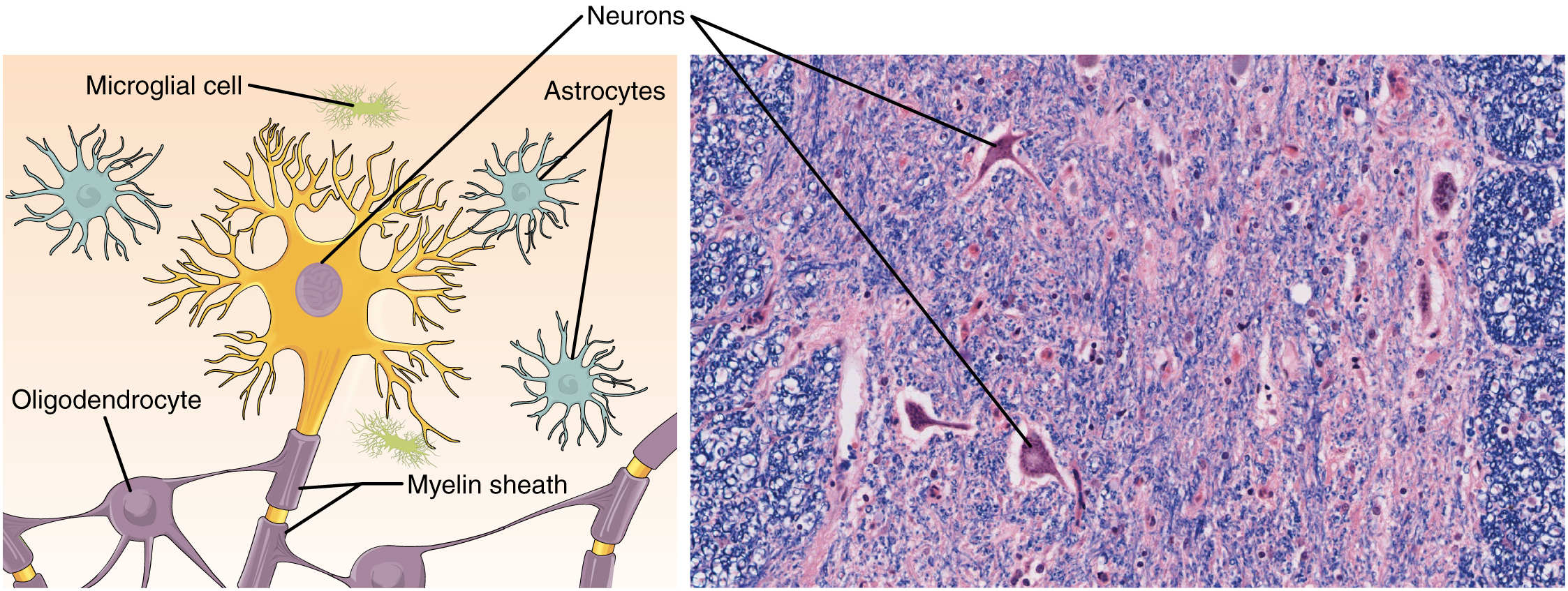
Nervous tissue is made up of neurons and other types of cells generally called glial cells (Figure \(\PageIndex{15}\)). Neurons are composed of cell body and extensions. The cell body contains the nucleus and the extensions make connections with the other tissues and neurons. Neurons transmit electrical messages and the glial cells play supporting roles. Nervous tissue makes up the central nervous system (mainly the brain and spinal cord) and peripheral nervous system (the network of nerves that runs throughout the rest of the body).
If you are a blood donor, then you have donated tissue. Blood is a tissue that you can donate when you are alive. You may have indicated on your driver’s license application that you wish to be a tissue donor in the event of your death. Deceased people can donate many different tissues, including skin, bone, heart valves, and the corneas of the eyes. If you are not already registered as a tissue donor, the information below may help you decide if you would like to register.
Each year, approximately 30,000 people donate tissues, which supply tissues for up to 1 million tissue transplants. One tissue donor can enhance or save the life of more than 50 people! Unlike organs, which generally must be transplanted immediately after the donor dies, donated tissues can be processed and stored for a long time for later use. Donated tissues can be used to replace burned skin and damaged bone and to repair ligaments. Corneal tissues can be used for corneal transplants that restore sight in blind people. In fact, each year 48,000 patients have their sight restored with corneal transplants. Unfortunately, there are not enough tissues to go around, and the need for donated tissues keeps rising.
Review
- Give an example of cells that function individually and move freely, and give an example of cells that act together and are attached to other cells of the same type.
- What are examples of cells that can readily divide and cells that can divide only under rare circumstances?
- Identify a type of cell that secretes an important substance and name the substance it secretes.
- Explain how different cell types come about when all the cells in an individual human being are genetically identical.
- Compare and contrast four subtypes of human bone cells.
- Identify three types of human white blood cells, and state their functions.
- Why are bone and blood both classified as connective tissues?
- Name another type of connective tissue, and describe its role in the human body.
- Based on the information in the table above of types of epithelial tissues, list four general functions of this type of tissue in the human body.
- Compare and contrast the three types of muscle tissues.
- Identify the four types of nervous tissues, where each type is found, and its basic function.
- Of the main types of human tissue, name two that can secrete hormones.
- Cells in a particular tissue:
- Are all of the same type
- Have different genes from cells in other tissues
- Work together to carry out a function
- Are always connected physically to each other
- Why are mucous membranes often located in regions that interface between the body and the outside world?
- Skin is a type of _____________ tissue.
- Body fat is a type of ____________ tissue.
Explore More
Each person’s body is completely unique, which means that everyone reacts differently to drugs and other medical treatments. In the TED talk below, tissue engineer Nina Tandon talks about a possible solution to this problem: making artificial tissues that are engineered to be the same as the patient’s and then using the tissues to test the effectiveness of specific drugs or other treatments.
Attributions
- Bronchiolar epithelium by Louisa Howard, released into the public domain via Wikimedia Commons
- Bone cells by OpenStax College, licensed CC BY 3.0 via Wikimedia Commons
- White blood cells by Blausen.com staff (2014). "Medical gallery of Blausen Medical 2014". WikiJournal of Medicine 1 (2). DOI:10.15347/wjm/2014.010. ISSN 2002-4436. licensed CC BY 3.0 via Wikimedia Commons
- Types of tissues by OpenStax College, licensed CC BY 3.0 via Wikimedia Commons
- Connective Tissue by Mandeep Grewal CC BY-NC 3.0
- Loose Connective Tissue by Adrignola original uploader was Sunshineconnelly, licensed CC BY 2.5 via Wikimedia Commons
- Adipose tissue by OpenStax College CC BY 3.0 via Wikimedia Commons
- Reticular tissue by OpenStax College CC BY 3.0 via Wikimedia Commons
- Dense regular and irregular by OpenStax College CC BY 3.0 via Wikimedia Commons
- Types of cartilage by OpenStax College CC BY 3.0 via Wikimedia Commons
- Bone Connective Tissue by Darshani Kansara licensed CC BY-SA 4.0
- Transverse Section Of Bone by BDB licensed CC BY-SA 2.5 via Wikimedia Commons
- Components of the Blood by OpenStax College CC BY 3.0 via Lumen Learning
- Classification of epithelial tissues by the US Government Public domain via Wikimedia Commons.
- Three types of muscle cells by OpenStax College CC BY 3.0 via Wikimedia Commons.
- Cells of Nervous tissue by OpenStax College CC BY 3.0 via Wikimedia Commons.
- Text adapted from Human Biology by CK-12 licensed CC BY-NC 3.0


